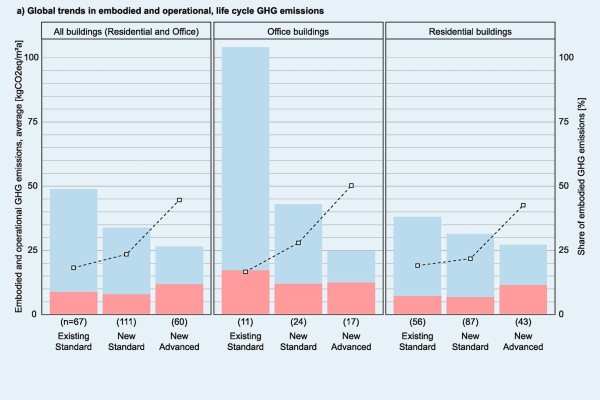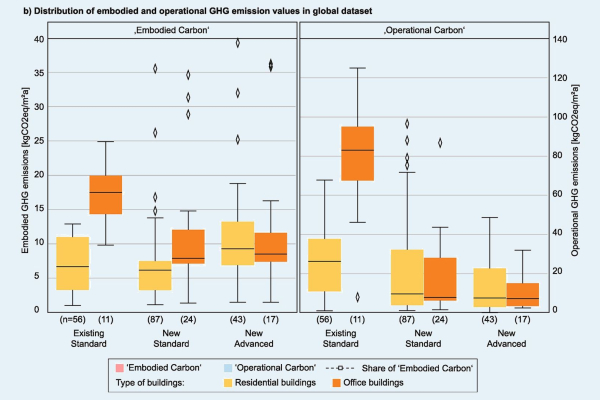
From the manufacture of building products to dismantling
Making the Full Life Cycle of Buildings Climate-Smarter
In Germany, there are almost 20 million residential buildings and nearly two million non-residential buildings, which fall under the scope of the German Buildings Energy Act (Gebäudeenergiegesetz (GEG)). All these buildings, from multifamily homes to office complexes, consume energy for heating, cooling, and water heating. Annually, the operation of buildings accounts for more than 30 % of energy consumption in Germany (approx. 3,084 petajoules and thus around 184 million tonnes of CO₂ in 2019). In order to achieve climate protection goals, buildings in operation must be supplied with energy in a climate-smarter and more efficient way.
However, is a building supplied entirely from renewable sources automatically climate-neutral in its life cycle? No, because grey energy and grey emissions (i.e. the amount of energy required and emissions created to produce the individual components) must also be taken into account. In addition, energy consumption and emissions that occur throughout the building’s life cycle as a result of repairs and modernizations, and finally the demolition and disposal of the components, must also be accounted for.
How can grey energy and grey emissions be measured and limited?
How can gray energy and gray emissions be measured and limited?
These gray emissions are also to be reduced with a view to climate targets. Researchers at the Karlsruhe Institute of Technology (KIT) have investigated how this can be achieved in the future in the KEA Building project (Fundamentals and Tools for Minimizing Energy Use and Greenhouse Gas Emissions in the Life Cycle of Buildings including contribution to IEA EBC Annex 72). The results of the research project have not only been incorporated into national guidelines during the project period, they are also intended to contribute internationally to reducing energy use and greenhouse gas emissions in the life cycle of buildings within the framework of IEA EBC Annex 72. The results have now been published.
The more efficient buildings become, the more the focus shifts to grey emissions
At the beginning of these considerations was the question of what actually counts as climate neutral. This is because the definition varies depending on the assessment model and country. The researchers analyzed 35 different approaches according to which buildings can be certified in different countries. The KEA Bauwerk team found the most ambitious approaches in Canada, France, Germany, Norway, Sweden, the United Kingdom and the United States. All of these approaches focused on being greenhouse gas neutral overall in the life cycle.
However, the various methodologies differed on issues such as how to account for electricity use in terms of appropriate emission factors, how to incorporate the time aspect, and how to offset emissions. How these differences play out is shown in another study. Here, the researchers examined the greenhouse gas emissions of an exemplary building using 17 different international approaches and databases for life cycle analysis.
According to the study, the biggest differences in the various methods are the LCA data used for the building products that were used in the analyses, the system boundaries of the building and life cycle model, and the period under consideration. However, although the calculated greenhouse gas emissions for the reference building differ, the individual results are relevant for comparisons in the respective national context. The researchers conclude that it is important that benchmarks fit the system boundaries of the life cycle analysis and the data basis in each country. They also found evidence that the manufacture and maintenance of building structures make a non-negligible contribution to the environmental impact of buildings and should therefore be included in life cycle analyses.
In order to better understand the extent to which life cycle assessments are already being used in practice today and what obstacles exist, the researchers also surveyed experts from architecture and construction planning in 23 countries. At the time of the survey, less than one-third of the respondents offered life cycle assessments or used them themselves. The main reason given by the experts was that there was too little demand from their customers. In Germany, only 16 percent of respondents have used life cycle analysis to date, but more than 30 percent planned to use it in the medium term.
However, more than half of the professionals (30 percent in Germany) already have practical experience with Building Information Modeling (BIM). BIM could therefore become an important tool for integrating lifecycle analyses into planning processes in the future. However, only 9 percent (4 percent in Germany) of planners have used corresponding functions and data for lifecycle analysis to date.
What is considered climate-neutral? A matter of definition
These considerations started with the question of what is actually considered climate-neutral since the definition varies depending on the assessment model and country. The researchers analysed 35 different approaches according to which buildings can be certified in different countries. The KEA-Bauwerk team found the most ambitious approaches in Canada, France, Germany, Norway, Sweden, the UK, and the USA. All these certificates focused on achieving greenhouse gas neutrality throughout the full life cycle.
What is building information modeling (BIM)?
Building information modeling (BIM) is a method of digital planning that involves creating a digital twin of a building. Using this digital model, planning, construction, and operation of the building can be optimized and it is possible to respond quickly to any changing requirements. The issue of LCAs can also be integrated into the BIM process.
However, the various methods differed with regard to the questions of how the use of electricity is taken into account in terms of corresponding emission factors, how the time aspect is included, and how emissions can be compensated. Another study shows the impact of these differences. Here, the researchers investigated the CO₂ emissions of a reference building using 17 different international approaches and databases related to life cycle assessment.
According to the study, the biggest differences between the various methods include the data on the building products LCA that were used for the analyses, the system boundaries of the building and life cycle model, and the period under consideration. However, although the calculated greenhouse gas emissions for the reference building differ, the individual results are relevant for comparisons in the respective national context. The researchers conclude that it is important that benchmarks correspond to the particular LCA approach and the data basis in the respective country. They also found evidence that the production and maintenance of building constructions make a significant contribution to the environmental impact of buildings and should therefore be included in life cycle assessments.
Strengthening knowledge of fundamentals and tools in architecture and construction planning
The researchers concluded from the results that not only relevant data and tools support an increased use of LCAs. In addition, it is important to establish standards and legal requirements to drive client demand. “We expect that binding provisions to limit greenhouse gas emissions in the life cycle of buildings will be introduced in Germany in the medium term,” says Lützkendorf. “Until then, architecture and construction planning should be prepared for this task and the industry should be provided with the necessary knowledge and tools for life cycle assessments. The demand must then come from the investors and building owners – initiated and increased by factors such as advantages in financing and valuation or due to legal requirements.”
Results are incorporated into national and international standards
The results of the KEA-Bauwerk project are being incorporated into the discussion on the development of European standards, which are also being adopted in the German set of standards, including DIN EN 15643 and the future EN 15978-1. The results directly contributed to the balancing rules for the German quality seal for sustainable building (QNG) and are currently playing a role in the discussions on a future GEG. The international cooperation within the framework of the IEA project collaboration has also led to the fact that information on the creation and development of databases is now being used in India.
After the conclusion of the IEA project at the end of 2022, project reports with detailed information, practical examples, and recommendations for action will be published. (Editorial note: After their publication, the reports will be made available at energiewendebauen.de). (ks)
Benchmarking and target setting for life-cycle environmental performance of buildings.
The researchers have come to the conclusion that benchmarks and target values are indispensable tools for assessing and influencing the environmental impact of buildings. With various principles and recommendations for action, they want to support the stakeholders involved in developing and applying such benchmarks and target values.
The complete report in English can be found here: EBC Annex 72: Assessing Life Cycle Related Environmental Impacts Caused by Buildings Benchmarking and Target-setting for the Life Cycle-based Environmental Performance of Buildings.
Context-specific assessment methods for life-cycle environmental impacts caused by buildings.
In this report, researchers focus on methodological issues related to the assessment of primary energy demand, greenhouse gas emissions, and other environmental impacts of buildings. The main objective is to provide a basis for the further development of specific assessment methods and to promote their global application in practice as well as the global standardization of the methods used.
The complete report can be found here: EBC Annex 72: Assessing Life Cycle Related Environmental Impacts Caused by Buildings Context-specific Assessment Methods for Life Cycle-related Environmental Impacts Caused by Buildings.
Further publications
- EBC Annex 72: Assessing Life Cycle Related Environmental Impacts Caused by Buildings Project Summary Report
- EBC Annex 72: Assessing Life Cycle Related Environmental Impacts Caused by Buildings Guidelines for design decision-makers
- EBC Annex 72: Assessing Life Cycle Related Environmental Impacts Caused by Buildings Case Study Collection
- EBC Annex 72: Assessing Life Cycle Related Environmental Impacts Caused by Buildings Understanding the Impact of Individual, Industry & Political Decisions on Transitions Towards Environmental Sustainability
- EBC Annex 72: Assessing Life Cycle Related Environmental Impacts Caused by Buildings Life-cycle Optimization of Building Performance: A Collection of Case Studies
- EBC Annex 72: Assessing Life Cycle Related Environmental Impacts Caused by Buildings Guidelines for Establishing an Easy-to-use National LCA Database for the Construction Sector
- EBC Annex 72: Assessing Life Cycle Related Environmental Impacts Caused by Buildings World Building Life-Cycle Based Databases and Repositories for the Building and Construction Sector



